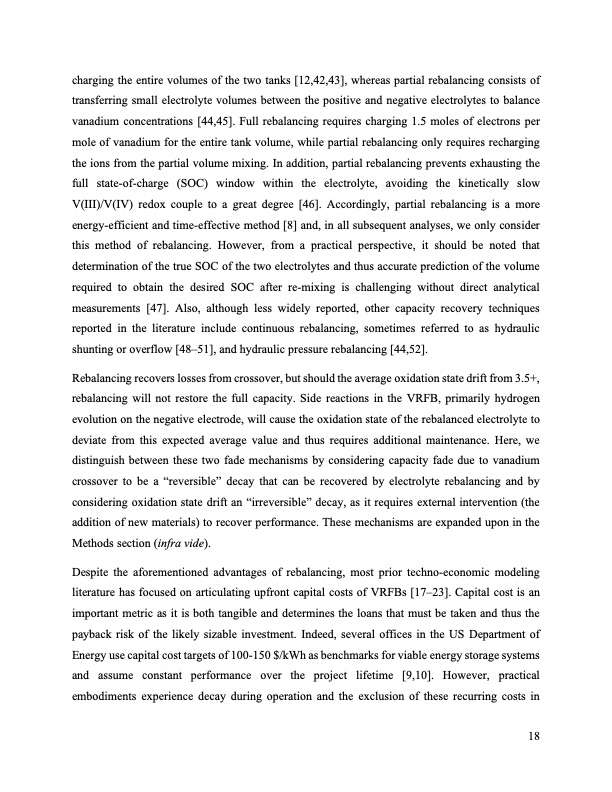
PDF Publication Title:
Text from PDF Page: 018
charging the entire volumes of the two tanks [12,42,43], whereas partial rebalancing consists of transferring small electrolyte volumes between the positive and negative electrolytes to balance vanadium concentrations [44,45]. Full rebalancing requires charging 1.5 moles of electrons per mole of vanadium for the entire tank volume, while partial rebalancing only requires recharging the ions from the partial volume mixing. In addition, partial rebalancing prevents exhausting the full state-of-charge (SOC) window within the electrolyte, avoiding the kinetically slow V(III)/V(IV) redox couple to a great degree [46]. Accordingly, partial rebalancing is a more energy-efficient and time-effective method [8] and, in all subsequent analyses, we only consider this method of rebalancing. However, from a practical perspective, it should be noted that determination of the true SOC of the two electrolytes and thus accurate prediction of the volume required to obtain the desired SOC after re-mixing is challenging without direct analytical measurements [47]. Also, although less widely reported, other capacity recovery techniques reported in the literature include continuous rebalancing, sometimes referred to as hydraulic shunting or overflow [48–51], and hydraulic pressure rebalancing [44,52]. Rebalancing recovers losses from crossover, but should the average oxidation state drift from 3.5+, rebalancing will not restore the full capacity. Side reactions in the VRFB, primarily hydrogen evolution on the negative electrode, will cause the oxidation state of the rebalanced electrolyte to deviate from this expected average value and thus requires additional maintenance. Here, we distinguish between these two fade mechanisms by considering capacity fade due to vanadium crossover to be a “reversible” decay that can be recovered by electrolyte rebalancing and by considering oxidation state drift an “irreversible” decay, as it requires external intervention (the addition of new materials) to recover performance. These mechanisms are expanded upon in the Methods section (infra vide). Despite the aforementioned advantages of rebalancing, most prior techno-economic modeling literature has focused on articulating upfront capital costs of VRFBs [17–23]. Capital cost is an important metric as it is both tangible and determines the loans that must be taken and thus the payback risk of the likely sizable investment. Indeed, several offices in the US Department of Energy use capital cost targets of 100-150 $/kWh as benchmarks for viable energy storage systems and assume constant performance over the project lifetime [9,10]. However, practical embodiments experience decay during operation and the exclusion of these recurring costs in 18PDF Image | Bringing Redox Flow Batteries to the Grid

PDF Search Title:
Bringing Redox Flow Batteries to the GridOriginal File Name Searched:
Rodby-krodby-phd-chemE-2022-thesis.pdfDIY PDF Search: Google It | Yahoo | Bing
Salgenx Redox Flow Battery Technology: Salt water flow battery technology with low cost and great energy density that can be used for power storage and thermal storage. Let us de-risk your production using our license. Our aqueous flow battery is less cost than Tesla Megapack and available faster. Redox flow battery. No membrane needed like with Vanadium, or Bromine. Salgenx flow battery
| CONTACT TEL: 608-238-6001 Email: greg@salgenx.com | RSS | AMP |